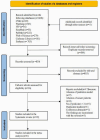Predictive model for CRT risk in cancer patients with central venous access devices: a systematic review and meta-analysis
- PMID: 40655105
- PMCID: PMC12245904
- DOI: 10.3389/fmed.2025.1580920
Predictive model for CRT risk in cancer patients with central venous access devices: a systematic review and meta-analysis
Abstract
Introduction: With the high incidence of central venous access device catheter-related thrombosis (CRT) in patients with cancer, its early onset, and the characteristics of clinically insignificant symptoms, risk assessment is essential for the targeted application of thromboprophylaxis. The aim of this paper was to review the risk prediction models developed for central venous access device CRT in patients with cancer and to evaluate their performance.
Methods: PubMed, Embase, Web of Science, Cochrane Library, CNKI, SinoMed, Wanfang Data, and VIP databases were searched, and the search timeframes ranged from the establishment of the database to May 22, 2024. Two researchers independently performed literature screenings, data extractions, and quality assessments. The risk of bias and applicability of the included studies were assessed using the Predictive Model Risk of Bias Assessment Tool. A meta-analysis of the areas under the curve (AUC) values for model validation was performed using Stata 17.0 software.
Results: Nineteen papers with 29 predictive models were included in this systematic review, reporting AUC values of 0.470-1.000. The incidence of central venous access device CRT in cancer patients ranges from 2.02 to 39.4%. The most commonly used predictors are D-dimer levels, BMI, and diabetes. All studies were judged to have a high risk of bias, mainly due to poor reporting of the areas analyzed. The combined AUC value of the six validated models was 0.81 (95% confidence interval: 0.76-0.86), indicating good model discrimination.
Discussion: Most available CRT prediction models exhibited moderate-to-good predictive performance. However, all the studies were rated as having a high risk of bias according to the PROBAST scale. Future studies should adhere to methodological and reporting guidelines for large-sample, multi-center external validation of models, focusing on studies that report rigorous design and optimization or on the development of new models.
Systematic review registration: PROSPERO, identifier: CRD42024516563.
Keywords: cancer patients; catheter-related thrombosis (CRT); central venous access devices; meta-analysis; risk prediction models.
Copyright © 2025 Yang, Fang, Cai, Pan, Zhang and Zhang.
Conflict of interest statement
The authors declare that the research was conducted in the absence of any commercial or financial relationships that could be construed as a potential conflict of interest.
Figures




Similar articles
-
Risk prediction models for deep venous thrombosis in patients with acute stroke: A systematic review and meta-analysis.Int J Nurs Stud. 2024 Jan;149:104623. doi: 10.1016/j.ijnurstu.2023.104623. Epub 2023 Oct 19. Int J Nurs Stud. 2024. PMID: 37944356
-
Drugs for preventing postoperative nausea and vomiting in adults after general anaesthesia: a network meta-analysis.Cochrane Database Syst Rev. 2020 Oct 19;10(10):CD012859. doi: 10.1002/14651858.CD012859.pub2. Cochrane Database Syst Rev. 2020. PMID: 33075160 Free PMC article.
-
Systemic pharmacological treatments for chronic plaque psoriasis: a network meta-analysis.Cochrane Database Syst Rev. 2021 Apr 19;4(4):CD011535. doi: 10.1002/14651858.CD011535.pub4. Cochrane Database Syst Rev. 2021. Update in: Cochrane Database Syst Rev. 2022 May 23;5:CD011535. doi: 10.1002/14651858.CD011535.pub5. PMID: 33871055 Free PMC article. Updated.
-
The comparative and added prognostic value of biomarkers to the Revised Cardiac Risk Index for preoperative prediction of major adverse cardiac events and all-cause mortality in patients who undergo noncardiac surgery.Cochrane Database Syst Rev. 2021 Dec 21;12(12):CD013139. doi: 10.1002/14651858.CD013139.pub2. Cochrane Database Syst Rev. 2021. PMID: 34931303 Free PMC article.
-
Risk prediction model for chemotherapy-induced nausea and vomiting in cancer patients: a systematic review.Int J Nurs Stud. 2025 Aug;168:105094. doi: 10.1016/j.ijnurstu.2025.105094. Epub 2025 Apr 24. Int J Nurs Stud. 2025. PMID: 40318314
References
Publication types
LinkOut - more resources
Full Text Sources
Research Materials

